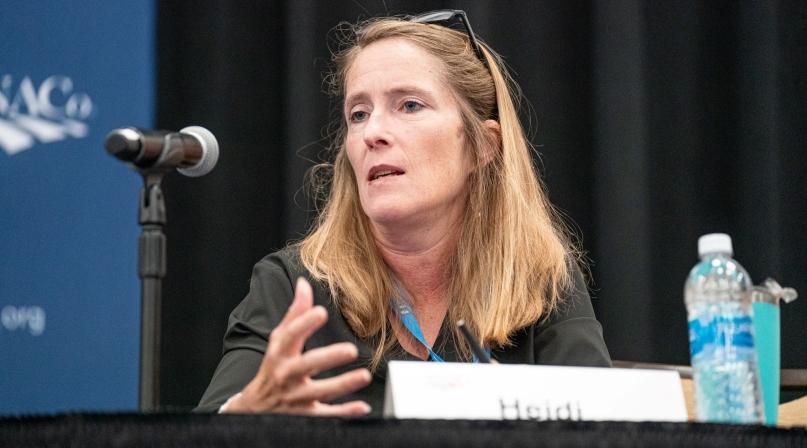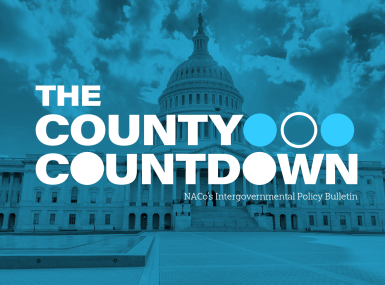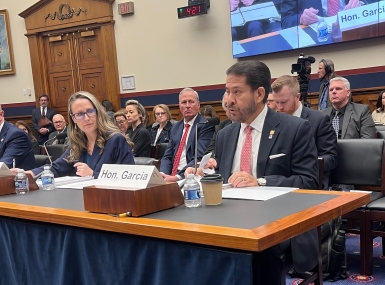A key to managing disasters: Targeted communication

Key Takeaways
“Prepare when the sky is blue,” is his mantra, Brunswick County, N.C. Commissioner Frank Williams, chair of the NACo Resilient Counties Advisory Board, told members July 13 at the Annual Conference.
It’s a message that many emergency managers and county officials heed. One way to use that “blue sky” time is to plan a risk communication plan, according to Heidi Stiller, the South regional director of the National Ocean Service Office for Coastal Management at the National Oceanic and Atmospheric Administration.
Resilient Counties Advisory Board
July 13
Find additional resources at Digital Coast Risk Communication topics page
“Often, we start with ‘I’m going to come up with a message,’” she said. “You need to back up, and ask ‘What’s my overall goal? Who is my audience?’”
The first step, she noted, is to not only define your audience but the outcome you hope to achieve. “You’ve got to get really specific,” she said, offering the audience a three-step blueprint to reach that goal.
Step 1: Define your risk communication audience and outcome.
• Challenge: What is your biggest risk communication challenge? (such as keeping flood risk mitigation on elected officials’ minds as they make decisions about the county’s safety and future).
• Audience: List the audiences you’re trying to reach. Consider who you want to take action or who is most at risk. Then get specific. Segment your audience. What characteristics will you use to segment your audience (such as by geography or demographics)?
• Outcome: What action do you want your audience to take because of your efforts?
Step 2: Understand your priority audience.
• What do you know about your audience? How do you know this information? What assumptions are you making about them?
• What would you want to learn about them? How will you learn more about them?
Step 3: Connect with your audience.
• How will you connect with your audience? Consider where you will find them. How will you design the interaction to meet their needs?
In addition to the three-step blueprint, Stiller also stressed the importance of learning why some residents will not evacuate. Find out their barriers — are they worried about their pets? Find solutions and communicate that information, before a disaster is imminent.
“We can’t wait for audiences to come to us,” she said. “You must go where folks are. Are you trying to reach business owners? Go to the Chamber of Commerce. Are you trying to reach neighborhoods? Go to the HOA or the farmers’ market.”
Another way to reach residents is through established partnerships such as local churches. “Establish those partnerships, find out who those trusted members of the community are,” she noted. “They can be great communicators for us.”
Explaining the risk is also valuable, she said, but “you don’t want to just throw science at people, that’s tempting, but you need to explain. Stories are super powerful, seeing the visuals and hearing the story about what can happen.”
When crafting a message to the public, “use plain language,” she said. “It’s not about dumbing it down. Use short words and short sentences.”
A clear message should “identify actions people can take and the benefits or losses avoided, she said. “Such as, “Turn Around, Don’t Drown.”
Related News

County Countdown – March 25, 2025
Every other week, NACo's County Countdown reviews top federal policy advocacy items with an eye towards counties and the intergovernmental partnership. This week features budget reconciliation, FY 2025 funding and more.

NACo testifies on the critical role of counties in disasters
NACo Intergovernmental Disaster Reform Task Force Co-Chair and Harris County, Texas Commission Adrian Garcia testifies before the House Transportation and Infrastructure Subcommittee on Economic Development, Public Buildings and Emergency Management.

White House signs executive order examining state and local preparedness
On March 18, President Trump signed an Executive Order aimed at aligning federal preparedness and response doctrines, while examining state and local preparedness capabilities. The order does not shift any responsibilities or costs to state and local governments, rather producing a set of recommendations for better collaboration across all levels of government.
County News
Disasters: ways resilient counties recover and mitigate

